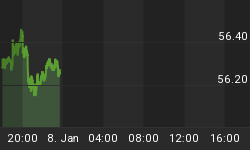The first phase of Americas involvement in the Middle Eastern war series has ended, and for the better part of 2003 the results have been propitious for the financial markets. Stocks, real estate, and commodities (in general) were all beneficiaries of war-time spending and performed extremely well. The U.S. will undoubtedly be mired in the Middle East for years to come, and while this will ultimately lead to the demise of the U.S. economy, in the coming few years it is likely to stimulate it and stall off the inevitable "Great Collapse," perhaps to as late as 2009-2014. But for now, let's focus on what is likely to be a series of bull markets in the years immediately ahead.
W.D. Gann in his 1936 book, "New Stock Trend Detector," wrote, "War in the past has always had a great effect on stocks and commodity prices. The starting of wars has often produced panics or sharp declines followed by booms, and after the war was over, there was another sharp decline or panic, followed by another boom with probably higher levels than occurred during the war days. It is important, therefore, to study the action of stocks and commodities around the beginning of war periods and after the ending of wars in order to detect what may happen in the future when these same conditions repeat." When we take the time to study these past conditions we must conclude that the past year of war and Congressional spending, if nothing else, has reversed the trend ofthe financial markets.
There is little doubt at this point that the 2000-2003 bear market in stocks has ended and a new "long-term" bull market is underway. By "long-term" I mean a bull market lasting at least two years or greater. While some will dispute this claim, a simple glance at a long-term monthly chart of the Dow Jones Industrial Average will suffice to prove my claim correct. A nearly 2 1/2-year downtrend line that began in 2001 was broken in September of this year, and a new uptrend channel has also begun. While a case could be made that stocks are over-bought in the short-term (and therefore a "correction" is in order), the longer-term trend is decidedly upward once again.

It is true that the Year 2004 should be an overall rocky year based on the fact that the 10-year equities cycle is scheduled to bottom late in the year, but even in 2004 there should be periods of rising stock prices similar to that of the second and third quarters of 2003. And assuming the 10-year cycle low doesn't violate the October 2002-March 2003 lows, the Dow will have confirmed a double bottom and will be on its way to making new highs into 2005.
How high? I'll leave that speculation to other forecasters, but I wouldn't be one bit surprised if the Dow didn't eventually exceed its early 2000 high near 12,000 within the next couple of years. In fact, if you look at a very long-term graph of the Dow Industrials you can see the beginnings of a classic "broadening top" pattern. Broadening tops can be quite volatile, but before they eventually top out they can produce extraordinary upside moves in relatively short spurts.

The XAU index reflects a continued bull market and has been making a series of higher highs and higher lows all year. Gold and silver are two other beneficiaries of the war-time stimulus, and along with copper and platinum, should continue to perform well over the next few years. Note the bullish long-term pattern in the XAU weekly chart below, a reflection of the precious metals bull market.

It isn't popular to be a long-term bull at this point in time, especially with so many high-profile, long-term bears still growling about Wall Street and the future of the U.S. economy. But one thing cannot be denied -- bull markets always follow wars as surely as day follows night. And whether you agree with it or not, the military spending will only further stimulate the U.S. economy and financial markets until the inevitable "day of reckoning" can no longer be forestalled (likely as we head closer to the 120-year cycle bottom in 2009-2014).
















